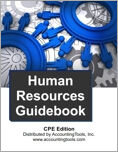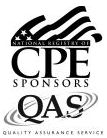Human Resources Guidebook (CPE Course)
CPE Credit: 20 hours
Course Type: Downloaded PDF materials with online test
Price (with PDF Textbook): $140

Course Description
Attracting and retaining the best employees is a herculean task, perhaps the most demanding one for today's manager. The Human Resources Guidebook
can be a valuable resource for the manager who needs a thorough knowledge of all issues relating to employees. The course describes how to plan for the appropriate staffing and skill levels, as well as how to design jobs and tailor recruiting campaigns to attract the correct types of candidates. There is extensive coverage of employee development, including career development, training programs, and succession planning. It also notes the many types of compensation and benefits, as well as their tax implications, and finishes with coverage of legal issues, including discrimination, related laws, and records management requirements. In essence, the Human Resources Guidebook
is the one-stop source for anyone who wants to develop a more effective human resources capability.
Author: Steven Bragg
Course Number: HR1005
Table of Contents
Chapter 1. Introduction to Human Resources
Chapter 2. Human Resources Strategy
Chapter 3. Job Analysis
Chapter 4. Workforce Planning
Chapter 5. Recruitment
Chapter 6. Applicant Evaluation and Selection
Chapter 7. Employee Assimilation
Chapter 8. The Work Environment
Chapter 9. Career Development
Chapter 10. Employee Training
Chapter 11. Succession Planning
Chapter 12. Performance Evaluation
Chapter 13. Termination of Employment
Chapter 14. Employee Compensation
Chapter 15. Employee Benefits
Chapter 16. Cost Reduction Concepts
Chapter 17. Human Resources Budgeting
Chapter 18. Labor Unions
Chapter 19. Discrimination Issues
Chapter 20. Laws Impacting Human Resources
Chapter 21. Human Resources Metrics
Chapter 22. Records Management
Learning Objectives
-
Cite the circumstances under which shared services can be used in human resources.
-
Specify the uses to which job rotation can be put, as well as the best utilization system for dealing with top talent.
-
Identify the uses of job descriptions, and how they are compiled.
-
Specify the factors that must be incorporated into workforce planning.
-
Recall the human resources planning response to a decline in sales.
-
Cite the tools used to recruit for job candidates, as well as to avoid the need for recruiting.
-
State the techniques used to locate those job applicants that are the best fit for a position.
-
Recall the ways to avoid discrimination claims arising from an interview.
-
Specify the effects that can skew an interviewer in favor of a particular candidate.
-
Identify the methods available for rapidly assimilating new employees.
-
Identify the techniques available for improving the work environment, as well as their advantages and disadvantages.
-
Specify the content of a personal development plan.
-
Cite the characteristics of a person on the leadership track.
-
Specify the role of succession plan administration.
-
Identify the techniques used to improve the effectiveness of training.
-
Define the types of ranking systems used in performance evaluation.
-
State the objectives associated with terminating employment.
-
Recall the topics covered with an employee when he or she is terminated.
-
Cite how compensation positioning is used to set compensation levels.
-
Specify the compensation problems associated with the piece rate system.
-
Recall the nature of the compensation issues for an exempt employee.
-
Identify the tax issues associated with employee benefits.
-
Identify the nature of a defined contribution retirement plan.
-
Recall the characteristics of phantom stock.
-
Specify the criteria for determining the status of a contractor.
-
Recall the actions that can be taken to manage an unemployment experience rating.
-
Specify the issues associated with a use it or lose it provision for earned vacation time.
-
Identify the different types of working condition benefits.
-
Specify the negative effects of cutting compensation and shifting benefits costs to employees.
-
Specify the methods used to compile the various labor-related budgets, and the uses of each budget.
-
Identify when certain payroll-related taxes are more likely to be recognized during a calendar year.
-
State the reasons why employees might want to join a union, and the process flow of the union certification process.
-
Specify the filing process for an unfair labor practice claim.
-
Recall the management role for the industrial relations staff.
-
Identify the protected classes under anti-discrimination laws.
-
Cite the roles of the federal agencies tasked with monitoring discrimination and affirmative action issues.
-
Identify the laws governing discrimination and the availability of insurance coverage for terminated employees.
-
Specify the situations in which various human resources metrics should be used.
-
Define the types of record keeping needed to document equal employment and other federal laws.
-
Identify the types of documentation used for the different types of warnings.
-
Recall the methods used to prevent unauthorized access to personnel records.
-
Specify the methods available for destroying personnel records.
Level: Overview
Instructional Method: QAS Self-Study
NASBA Category: Personnel/Human Resources
Prerequisites: None
Advance Preparation: None
Latest Review Date:December 2022
Program Registration Requirements: Click on "Purchase Course" near the top of this page to pay for and access the course. You will then be able to download the course as a PDF file, then take an on-line examination, and then download a certificate of completion if you pass the examination.
Program Refund Policy: For more information regarding administrative policies concerning complaints, refunds, and other matters, see our policies page.

AccountingTools, Inc. is registered with the National Association of State Boards of Accountancy (NASBA) as a sponsor of continuing professional education on the National Registry of CPE Sponsors. State boards of accountancy have the final authority on the acceptance of individual courses for CPE credit. Complaints regarding registered sponsors may be submitted to the National Registry of CPE Sponsors through its website: www.nasbaregistry.org .
The NASBA sponsor identification number for Accountingtools, Inc. is 115881.

AccountingTools is an IRS Approved Continuing Education Provider. We are compliant with the requirements for continuing education providers (as described in sections 10.6 and 10.9 of the Department of Treasury’s Circular No. 230 and in other IRS guidance, forms, and instructions). Our IRS Approved Continuing Education Provider number is 72821.

